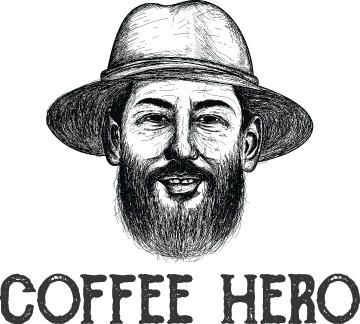
Coffee Extraction
The Extraction Code: Why Your Coffee is Bitter or Sour (And How to Fix It Forever)
The Code Unlocked (The Quick Version)
Every bad cup of coffee you've ever had was caused by one thing: bad extraction.
Extraction is just the process of water dissolving flavour from coffee grounds. It has three simple stages:
-
Under-extracted: Not enough flavour was dissolved. Your coffee tastes SOUR.
-
Perfectly-extracted: Just the right amount of flavour was dissolved. Your coffee tastes SWEET & BALANCED.
-
Over-extracted: Too much flavour was dissolved. Your coffee tastes BITTER.
Your only mission as a home brewer is to land your coffee in that perfect "sweet and balanced" spot.
You control this with 5 simple "levers": Grind Size, Brew Time, Water Temperature, Ratio, and Agitation.
This guide will teach you how to master these levers and never brew a bad cup of coffee again. It's that simple.
The One Secret That Explains All Bad Coffee
We've all been there. You brew a coffee at home, take a sip, and... it's just not right. Maybe it's brutally bitter, maybe it's weirdly sour, or maybe it's just weak and watery. You blame the beans, the machine, the moon, anything.
But what if we told you that every single one of those problems was caused by the exact same thing?
Welcome to The Extraction Code. The single, unifying theory that explains all bad coffee. This isn't just another brewing guide filled with confusing steps. This is the master key. Once you understand extraction, you will not only know how to fix your coffee, you will understand why it went wrong in the first place.
The mystery and frustration ends today. Let's begin.
Chapter 1: The Extraction Spectrum - Your Map to Flavour
Let's get one thing straight: extraction is just a fancy word for dissolving. When you brew coffee, you're just using water to dissolve the solid, tasty stuff out of the coffee grounds.
The secret is that different flavours dissolve at different speeds.
-
The sour, acidic flavours dissolve first (and very easily).
-
The sweet, balanced, and complex flavours dissolve next.
-
The heavy, bitter flavours dissolve last (and take the longest).
This creates a "flavour journey" that we call The Extraction Spectrum. Your job is to stop the journey at the perfect moment.
A Roaster's Deep Dive: Extraction Yield and TDS
To move beyond just tasting your coffee and start measuring it, we introduce two critical scientific concepts used by professional baristas and roasters: Extraction Yield (EY) and Total Dissolved Solids (TDS).
-
Extraction Yield (EY): This is the percentage of the dry coffee grounds that were dissolved into the water. The Golden Zone corresponds to an EY of 18% to 22%.
-
Total Dissolved Solids (TDS): This is the percentage of the final beverage that consists of dissolved coffee solids. For filter coffee, the ideal TDS is usually 1.15% to 1.35%.
These two measurements form the foundation of the SCA's Coffee Brewing Control Chart, a professional tool for perfectly dialling in your brew.
Understanding Under-Extraction (The Sour Zone: <18% EY)
This is what happens when your brew is too quick or inefficient. The water only had time to dissolve the easiest-to-grab flavours - the light organic acids (citric, malic). It didn't have a chance to reach the deep sweetness. The result is a coffee that can taste aggressively sour (like an unripe lemon), sometimes even salty, and feels thin and unsatisfying in your mouth.
Achieving The Golden Zone (The Sweet Spot: 18%–22% EY)
This is coffee nirvana. Here, you've dissolved all the sour acids, but you've balanced them out perfectly with the deep, sweet sugar compounds (carbohydrates). This is where you find the incredible, complex flavours listed on your bag of specialty coffee beans. The coffee tastes vibrant, sweet, and has a pleasant, long-lasting aftertaste. This is our goal, every single time.
Understanding Over-Extraction (The Bitter Zone: >22% EY)
This is what happens when your brew is too long or too aggressive. The water has dissolved all the sours, all the sweets, and has now started to break down the very woody structure of the coffee bean itself, dissolving heavy, bitter compounds like polyphenols. The resulting coffee will taste harsh, unpleasantly bitter, and leave a dry, chalky feeling in your mouth (this is called astringency).
Chapter 2: The 5 Levers of Power - How to Control Extraction
Okay, so how do you control this process to make sure you always land in The Golden Zone? You have a control panel with five simple "levers."
Lever 1: Grind Size (The Master Lever)
This is the most important lever you have. Grinding coffee changes its surface area.
-
Finer Grind = More Surface Area = Faster Extraction. (More of the bean is exposed to water).
-
Coarser Grind = Less Surface Area = Slower Extraction. (Less of the bean is exposed to water).
If your coffee is sour, you need more extraction, so you should grind finer. If your coffee is bitter, you need less extraction, so you should grind coarser. A high-quality burr grinder is the secret weapon of every hero, because it gives you precise control over this lever.
Lever 2: Brew Time
This one is simple. The longer your water and coffee are in contact, the more extraction will happen. A 2-minute pour-over will be less extracted than a 4-minute pour-over. This is the dial you turn after you've set your grind size.
Lever 3: Water Temperature
Hot water is a more effective solvent than cold water because heat increases the rate of chemical dissolution.
-
Hotter water = Faster, more aggressive extraction.
-
Cooler water = Slower, more gentle extraction.
The globally recognised "golden range" for coffee brewing, as confirmed by the Specialty Coffee Association (SCA), is between $92^\circ \text{C}$ and $96^\circ \text{C}$ ($195^\circ \text{F}$ and $205^\circ \text{F}$). Brewing below $90^\circ \text{C}$ almost guarantees an under-extracted, sour cup.
Lever 4: Coffee-to-Water Ratio (The Strength Dial)
While this lever primarily controls the strength of your final cup (TDS), it indirectly impacts how quickly the water gets saturated with coffee solids. The "Golden Ratio" that baristas use as a starting point is 1 part coffee to 16 parts water (1:16). Using a precision digital scale to nail this ratio is the key to a balanced, not watery, brew.
Calculation Corner: The Brew Ratio Formula
Example: For $20\text{g}$ of coffee at a 1:16 ratio, you need $20 \times 16 = 320\text{g}$ of water.
Lever 5: Agitation
"Agitation" is just a fancy word for stirring the coffee or how you pour the water. It increases the contact between water and coffee, speeding up extraction. Too much turbulence (aggressive pouring) can lead to bitter spots, while too little (a gentle drizzle) can lead to under-extraction. Learn to pour slowly and evenly.
Chapter 3: The Training Ground - Putting the Code into Practice
Reading is one thing. Doing is another. It's time for your "light bulb moment." We'll use a simple Plunger (French Press) for this mission, as it isolates the variables beautifully.
The Mission: The 3-Cup Experiment
Grab your plunger and your favourite Coffee Hero beans. You're going to brew three small, separate cups. Always use the 1:16 ratio for consistency.
| Cup | Grind Setting | Brew Time | Expected Taste | Action if Sour/Bitter |
| 1 | Very Coarse | 2 minutes | Under-Extracted (Sour) | Too little contact time. |
| 2 | Very Fine | 8 minutes | Over-Extracted (Bitter) | Too much contact time. |
| 3 | Coarse | 4 minutes | Golden Zone (Sweet) | Balanced time for coarse grind. |
You have just tasted the entire Extraction Spectrum. This practical knowledge is now yours forever.
Chapter 4: The Diagnostic Matrix - Your Troubleshooting Guide
This is your new secret weapon. Any time you make a bad cup of coffee, consult this chart. It will tell you exactly what went wrong and how to fix it.
| IF YOUR COFFEE TASTES... | THE PROBLEM IS... | THE PRIMARY FIX (More Extraction) | THE SECONDARY FIX (More Extraction) |
| Sour, Salty, Thin, Gassy | Under-Extraction | Grind Finer | Brew Longer OR Use Hotter Water |
| Bitter, Harsh, Dry, Astringent | Over-Extraction | Grind Coarser | Brew Shorter OR Use Cooler Water |
| Weak and Watery | Bad Ratio (Too Dilute) | Use Less Water for the same coffee (e.g., try 1:15 instead of 1:16). |
The Final Revelation: You Hold the Keys
You came to this page with a problem: bad coffee. You leave with the code to solve it, forever.
Bitterness is no longer a random mystery; it is simply over-extraction. Sourness is no longer a sign of "bad beans"; it is simply under-extraction.
You are no longer a victim of your coffee maker. You are its master. You hold the 5 levers. You see the code behind the curtain. The perfect cup is no longer a happy accident; it is now a deliberate, repeatable action.
The Explorer's Almanac (Frequently Asked Questions)
What are the 3 stages of coffee extraction?
The three stages of flavour dissolving are the sours/acids (which come out first), the sweets/complex notes (which come out in the middle), and the bitters/heavy compounds (which come out last).
What is the perfect extraction for coffee?
The perfect extraction is the "Golden Zone," where the Extraction Yield is between 18% and 22% and the TDS is around 1.2%. This sweet spot balances the initial acidic compounds with the sweet sugars, resulting in a complex and vibrant cup.
What factors affect coffee extraction?
The five key factors, or "levers," are your Grind Size, Brew Time, Water Temperature, Coffee-to-Water Ratio, and Agitation (stirring). For a deeper look into the research that defines these standards, you can explore resources from World Coffee Research
How do you fix under-extracted coffee?
You need to extract more. The easiest way is to use a slightly finer grind on your next brew. You can also increase your brew time or check that your brew water is hot enough (ideally over $92^\circ \text{C}$).
How do you fix over-extracted coffee?
You need to extract less. The easiest way is to use a slightly coarser grind on your next brew. You can also decrease your brew time or ensure you are not over-agitating the coffee bed.
What is the golden rule of coffee extraction?
The golden rule is to aim for a balanced brew that is neither sour nor bitter. It's about finding that delicious sweet spot in the middle of the Extraction Spectrum.
Check out this article: Signs That Your Coffee Is Over-Extracted: What To Do
You have cracked the code. You are no longer a beginner; you are a brewer.
The final step is to apply this powerful new knowledge to ingredients that are worthy of your skill. A hero deserves a heroic bean.
Explore our collection of freshly roasted coffee beans and invest in a precision burr grinder to extract your first true masterpiece.
As soon as we roast our beans they are packed and shipped to you immediately. When it arrives at your doorstep, it’ll be the freshest coffee you’ve ever tasted. Order online for delivery.

